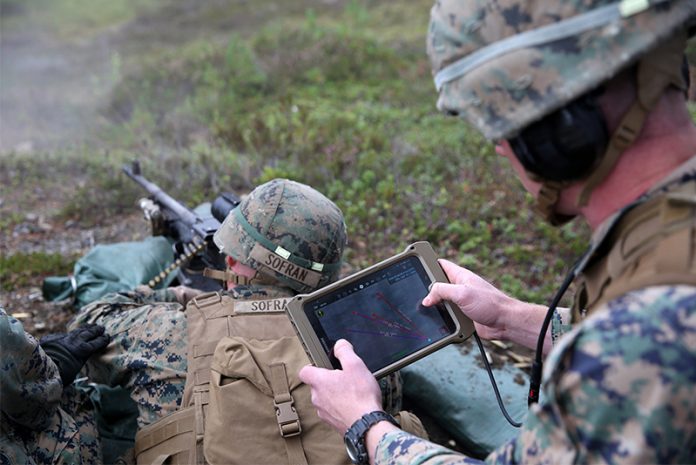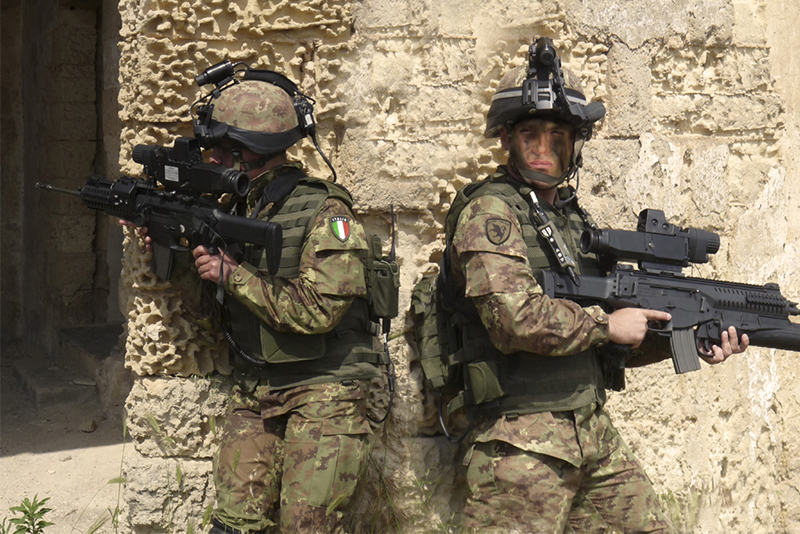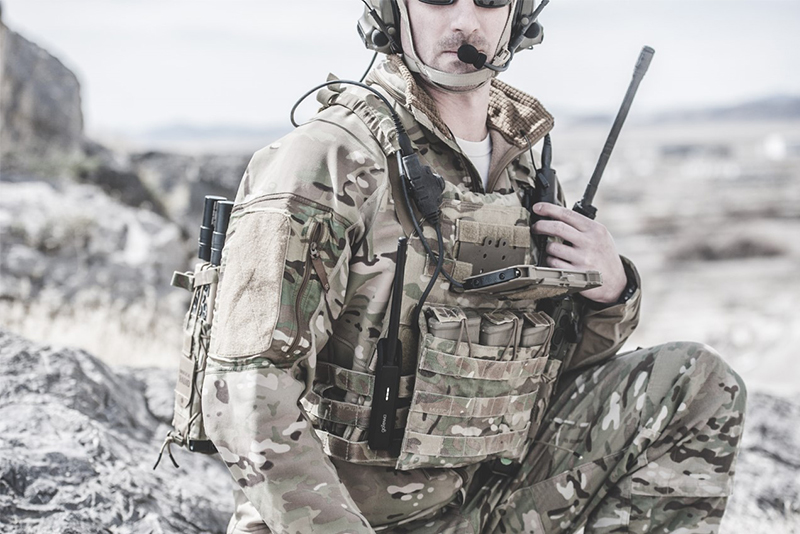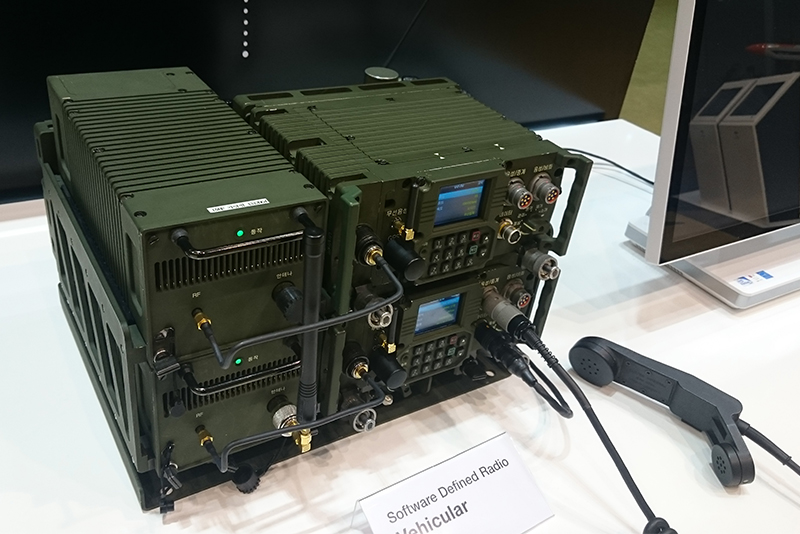
Giving every soldier the ability to send and receive voice and data communications can be done, but will add to or decrease capability in combat?
Battlefield Communications
The ability to send and receive information and direction is critical to conducting effective battlefield operations. This is particularly so at the squad, platoon and company levels. These also must deal with broken terrain and vegetation that can obstruct observation and signals. During rapidly changing situations, leaders are extremely reliant on information received from their soldiers positioned forward in developing a picture of the situation before them.
Unit leaders also need to issue directions to respond by manoeuvre and direct and supporting fires to win their particular battle. Communications at the small unit level is critical yet has also been in the past the most neglected.
Given the increasingly distributed nature of combat on today’s battlefields, communications at company level and below is now receiving increased attention. This move is perhaps aided by the proliferation of individual cell phones. Individual soldiers are comfortable with personal communications devices and have an expectation for being kept aware and even actively contribute to the dialogue within the unit.
Intra-Squad Communications
Small unit battlefield communication must address often conflicting demands of each unit level. Within the squad, distances are relatively short, typically inside 500 to 800 metres, with communication primarily focused on immediate events and direction.
Operation of the radio needs to be almost intuitive, while not distracting from the soldier’s attention to his surroundings or ability to react to contact. Being able transmit while handling and firing a weapon is required too. So individual squad radios should be simple and straight forward to use.

Leonardo PRR (Personal Role Radio)
A single channel can be considered adequate while achieving a lower weight and maximising battery life. The Selex (now Leonardo) PRR (Personal Role Radio) fielded by the British military in 2002 is an early example. With a 500m range it is compact and less than 1.5kg (3.3lbs). It features a wireless ‘push to talk’ fob that can be weapon or grip mounted and are specifically designed for platoon and section front line use. A later enhanced model, EZPRR, extends the range to 800m and includes encryption, data transmission, and re-broadcast.
Although individual soldier radios are receiving emphasis as a combat multiplier, it is not definitively established that this is always the case. US Army Dismounted Battle Lab and Marine Corps Warfighting Lab field experiments between 1998 and 2002 offered inconclusive results.
An often overlooked factor of the intra-squad radio is that to be effective it needs to be provided to every squad member. So price should be a primary driving factor yet often overly complex requirements and contract order quantities that are below the scales essential to achieving economical manufacturing have at times predicated against this.
Motorola SRX-2000 Combat Intra-squad radio
The Motorola SRX-2000 Combat Intra-squad radio which was fielded by the US Marines in 2012, took another approach to achieving affordability. Paul Mueller, vice president at Motorola Solutions shared that “the SRX-2000 is based on our APX line that provides powerful performance in a COTS solution that an affordable alternative to purpose-built radios.” With personal intra-squad radios enhancing combat capabilities is more a factor of their widespread use than it is the number of features that a radio has.
Location Tracking
Another capability that is having an impact on battlefield communications at all levels is GPS. It is now embedded in electronics offering every person a view of their own location.
When incorporated with broader systems like Blue Force Tracking, it is able to share that information so as to provide an overall picture of the disposition of others. This permits unit leaders to know where their team members are without needing to interrogate them. It can, however, potentially create a problem in that it requires viewing a graphic display thereby distracting the soldier.
Having a frontline soldier becoming too focused on an electronic device rather than his surroundings has been a concern. Military leaders have suggested this can be addressed through training. In addition, efforts are moving forward to field helmet mounted ‘heads-up’ displays that could present this information without looking down.
Squad and Platoon Leader Comms
This level of communications requires reliable exchange both within the unit and up to the next level which means connecting on at least two separate channels. This can be met by either providing two separate radios or through a single radio with dual channel capability.
In the former the leader may carry a PRR or General Dynamics Mission Systems AN/PRC154A single channel Rifleman’s Radio for contact with the team and a separate more powerful radio to talk with other leaders within the platoon. Leonardo offers a special PTT that allows a single control for both radios.

The alternative is a dual channel capability in a single radio. In this category, the L3Harris AN/PRC-150, which is being introduced by the Australian army, offers both VHF and HF signal at one, five or 10 watts output. Another is the Thales AN/PRC-148 Multiband Inter/Intra Team Radio (MBITR) which weights only .867kg (1.91lbs) and up to 5W power.
Beyond eliminating the need to carry an additional load, these multi-channel radios also allow leaders to directly call for and control supporting fires. To accomplish these tasks these ‘Leader’ radios need greater range on the order of at least several kilometres and increased levels of security as they can be expected to receive information projecting future mission needs.
Dual Band Radio
“The dual band radio”, explained a representative of Thales Group, “allows for communications on the UHF (ultra-high frequency) and VHF (very-high frequency) bands. They allow transmitting on one band while receiving on the other.”
UHF is primarily line-of-sight making it more useful in ground to ground communication at shorter ranges so it is typically best for connecting intra-platoon and squad.
VHF, on the other hand, has greater range and is less influenced by obstructions. As a result it is preferred for platoon and higher as well as for requesting and controlling supporting fires.
Low weight is still a consideration for the squad and platoon leader as he must carry all his combat equipment and the radio.
Mounted and Dismounted Operations
Thales’ SYNAPS-H handheld V/UHF radio is intended for platoon and squad leader use in both dismounted and mounted operations where it can be docked to a vehicle station which boosts its power to 50W.
This later ability to provide communication when on foot but to be able to transition to use when in a vehicle is an important consideration especially for mechanised and motorised infantry.
The transition from vehicle to being outside needs to be seamless both in maintaining voice and data contact with the teams, higher command, and the vehicle. Here the necessity for assuring sound situational awareness is critical toward capitalising on the mutual support that makes the infantry and combat vehicle team so effective.
Patrick Curlier, sales manager at Safran Defence explained in a paper how its FE´LIN, French infantry integrated combat system, provides dismounted communication using the Thales PR4G V54 or coming new generation RIF radio which gives access to the broader tactical picture.
In addition, individual infantry radios are able to be recharged by the vehicle addressing a continuous concern of man-portable radios – staying powered. Leonardo’s Platform PRR similarly ties its personal role radios into the vehicle communications thereby assuring the information exchange between the leaders, crew and the infantry section.

Tablet
An additional tool that is being now introduced to the platoon and squad leader is the digital tablet which is widely used in the public and private sector.
The US Marines are fielding MCH (Marine Air-Ground Task Force Common Handheld), a commercially based tablet that contains interactive tactical mapping with GPS providing a common networked tactical picture. Further it contains ‘chat’ functions and pre-formatted messaging that can be used to exchange orders, reports, and plot positions. Safran is offering a similar SIT COMDE tactical tablet for section leaders.
A promising concept being introduced to tactical communications is ‘networking’ such as provided in the goTenna Pro-X.
It uses a 79g (2.8oz) radio transmitter/receiver that links via USB or Bluetooth connection to a user’s iOS or Android smart phone. These mesh with other devices providing a local network which exchanges near real time position data and allows texting.
Jim Schueren, vice president Institutional Business Development & Sales at goTenna shared that “groups of devices can be programmed on separate frequencies permitting them to operate without interference. The nominal range for each device is around 6.5km; however, their ability to link to one another allows them to ‘hop’, thus considerably expanding their coverage facilitating passing data to higher command levels.

Company Command and Support
Increasingly the company is becoming the focal point for combat operations. It is in many ways complementing and even supplanting the battalion as the principle ground manoeuvre element in some tactical scenarios. As such company command becomes the focal point for control of the rifle platoons, the organic support of the weapons platoon consisting of crew served mortars, machine guns, and anti-tank/direct fire system, as well as external artillery and air support. These do not differ appreciably if the unit is mounted or dismounted. Directing and coordinating these assets demands longer range, greater frequency access, and higher transmission security.
Manpack radios
Manpack radios such as the Collins Aerospace AN/PRC-162 a multi-channel, software defined radio with modernised cryptosystem and advanced waveforms fill these roles. A Collins representative indicated that “Our TruNet uses the US Department of Defense (DoD) new MUOS (Mobile User Objective System); it offers true air-ground interoperability.”

It operates in both narrow and wide bands providing high speed mobile ad hoc networking, point-to-point data, voice, and next-generation SATCOM across two independent channels and includes internal GPS. The operating weight is 6.03kg (13.3lbs) which typically is carried by a dedicated RTO (radio operator), however, the PRC-162 can also be vehicle mounted.
The army of the Republic of Korea is fielding a new tactical radio ‘family’ in its TMMR (Tactical Multi-band Multirole Radio) which is intended to fill requirements for handheld, man-portable and vehicle. These utilise Very and Ultra-High Frequencies for company and platoon level communication in mounted and dismounted applications.

Tablet
The digital tablet’s capabilities are also be capitalised on at company level. These are particularly efficient in control of fire support. The USMC Target Hand-off System 2.0 is an adaption of a commercial tablet that simplifies support requests by using pre-formatted messages. It is also interoperable with the AN/PRC-117 radio and Common Laser Rangefinder-Integrated Capability System. It offers faster and more responsive observer to weapons fire support through digital messaging.
Voice vs Data
One of the key developments in communications is the introduction of data transmission made available through digitalisation. Although often viewed as a supplement to voice communications at the small unit level, it holds the potential to significantly alter how information is exchanged and the efficiency of data flow.
A programme official at L3Harris explained, “Like texting on your personal cell phone, digital messaging can send more information, more reliably, and securely even in degraded environments.” This format can, from a performance stand point, in some applications be preferable to voice.
However, currently inputting information can be less convenient, particularly in a fast moving situation such as when in contact. In addition, presentation of digital messaging remains principally graphic and must be read which for the infantryman can be distracting, although an entirely acceptable option for vehicle and weapon system crews.
Another aspect of digital is its ability to send and receive graphics and photos. This can enhance the clarity of mission briefings and facilitate the passing of details in situation reports both up-the-chain of command and down to individual soldiers. The pursuit of including live video feed, although possibility reassuring to high command viewers, offers little benefit to the execution of an operation.
Where to from here?
Providing individual communications to the combat soldier on a wide scale is relatively new. Doing so has been equally influenced by renewed recognition of the potential advantages and enhanced combat capabilities it offers.
Digitalisation and electronics miniaturisation have contributed to addressing the need for such radios to be compact and low weight.
But the question remains of how far information can or should be distributed. Too much communication can equally be a concern as having too little. The challenge is in ascertaining where that line is and applying it on the battlefield.












